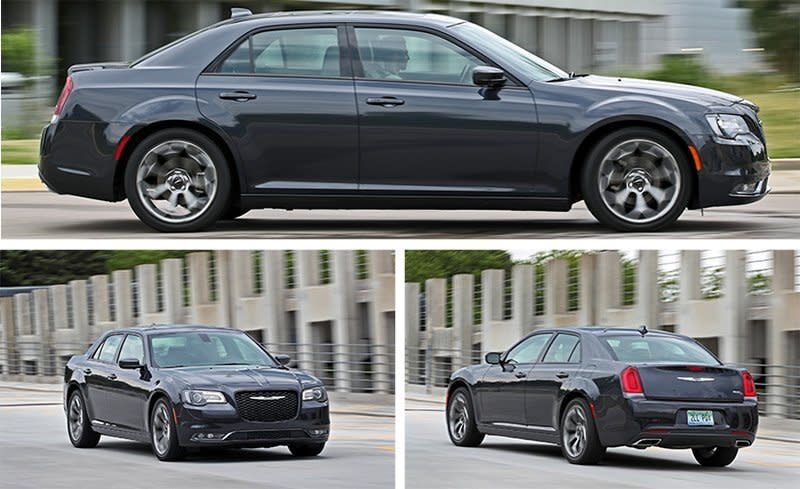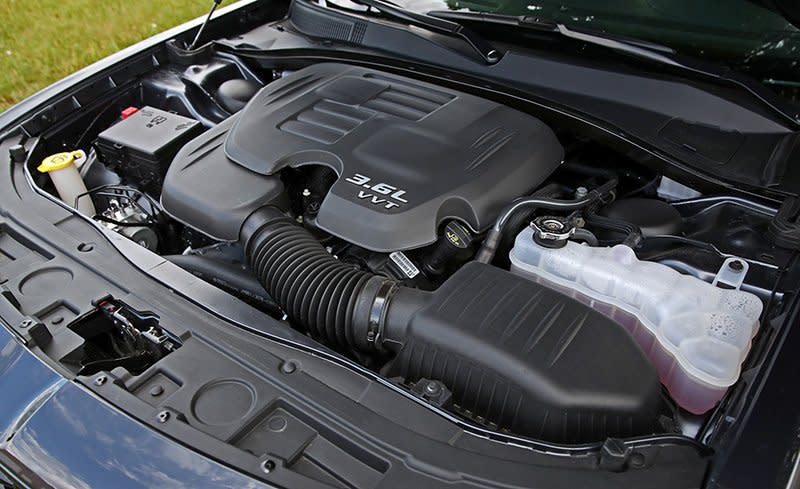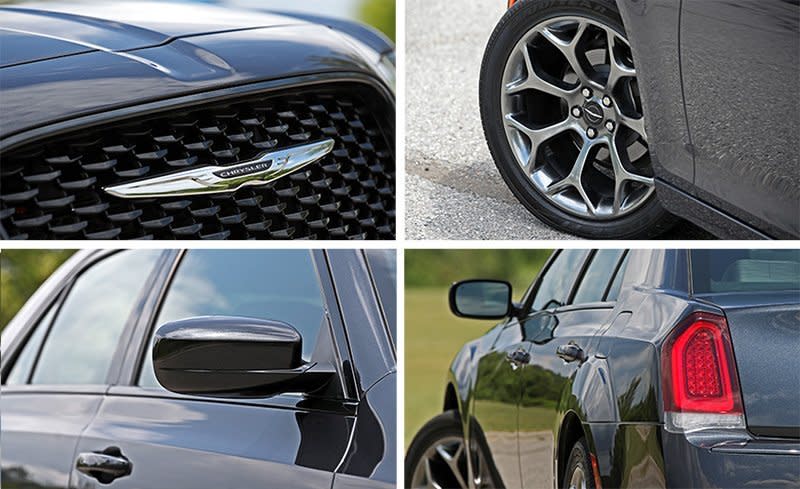2017 Chrysler 300S V-6 RWD

Sixty-two years ago, Chrysler kicked off its now famous 300 model line with the introduction of the C-300 coupe. Armed with a 300-hp 5.4-liter V-8 engine, the C-300 became an instant NASCAR icon. By the close of the 1955 NASCAR season, the C-300 had taken home 23 checkered flags—13 more than second-best finisher Oldsmobile.
How times change. Chrysler long ago traded the C-300’s stately two-door styling and racing pedigree for the square-jawed looks and sedan body style that have marked the modern 300 for more than a decade. And whereas the original C-300 was unavailable with luxuries such as air-conditioning, the 2017 Chrysler 300 embraces its role as the brand’s flagship sedan. Even the entry-level 300 Limited comes standard with features such as leather, powered and heated front seats, a proximity key with push-button start, and dual-zone automatic climate control.

S without the RT
Those in search of a 300 with increased driver engagement will need to step up to the $36,770 300S. It’s denoted by a menacing blacked-out grille and lower fascia, black headlamp bezels, and attractive 20-inch wheels, and comes equipped with a firmer suspension and a specially tuned variant of FCA’s 3.6-liter V-6 engine that makes 300 horsepower and 264 lb-ft of torque (gains of 8 horses and 4 lb-ft over other V-6 300s). A standard eight-speed automatic transmission with steering-wheel-mounted paddle shifters channels the 300S’s output to the rear wheels. All-wheel-drive is a $2500 option, and $3000 buys an upgrade to the 363-hp 5.7-liter V-8—but you can’t combine the two.
Although the V-6 in the 300S won’t win this big brick any drag races, the 300-hp engine offers enough grunt to move the two-ton-plus sedan off the line with confidence. Our 4089-pound test car charged to 60 mph in 6.3 seconds and through the quarter-mile in 15.0 flat at 96 mph, besting a 300 with the 292-hp V-6 by 0.2 and 0.1 second.
While the eight-speed automatic swapped cogs with the alacrity of an old-time switchboard operator, the transmission’s eagerness to reach top gear hurt the 300S’s passing performance. The Chrysler needed 4.9 seconds to accelerate from 50 to 70 mph—a full second longer than the Nissan Maxima. Push the dashboard-mounted Sport button and the transmission holds gears longer; it also cuts shift times from a claimed 400 milliseconds to a snappy 250 milliseconds. Additionally, Sport mode firms up the steering and quickens the throttle.

Even in Sport mode, though, the 300S never fully seduces the driver. Although our test car’s Goodyear Eagle F1 Supercar summer tires—a steal at $95—helped the sizable sedan pull an impressive-for-its-class 0.88 g around our 300-foot skidpad, the Chrysler feels more at home cruising on the highway than it does tackling twisty two-lanes.
Unfortunately, this model’s stiffer suspension setup results in a rougher ride over pockmarked pavement compared to its softer-sprung stablemates. We’d strongly consider sacrificing the 300S’s extra ponies for the more refined ride of the lesser 300 Limited V-6 or the luxury-lined 300C, the latter of which also can be optioned with the Hemi V-8.
Regardless of trim, every rear-wheel-drive 300 V-6 earns the same EPA ratings of 19 mpg city and 30 mpg highway. During our time with the 300S V-6 we recorded 23 mpg overall, matching the EPA’s combined figure. Likewise, our 75-mph highway fuel-economy test resulted in 30 mpg, again spot on the EPA number.

Superior Interior
Despite its rather staid styling, the 300S’s cabin is a fine place to while away the miles, with its well-cushioned front bucket and rear bench seats. Our test car let in just 69 decibels of noise at 70 mph, making its cabin as quiet as that of the much pricier Volvo S90 T5. Every 2017 Chrysler 300 also benefits from Chrysler’s latest Uconnect 4 infotainment software. It features the prior Uconnect system’s logical menu structure, general ease of use, and 8.4-inch display, but adds sharper graphics, Android Auto and Apple CarPlay capability, and a host of new touchscreen functions, including the ability to pinch to zoom in or out on the optional $995 navigation system’s map.
We’d gladly do without the 300S-specific piano-black trim that is a magnet for fingerprints, and we’d skip our test car’s $1795 panoramic sunroof, as it cuts front-seat headroom by 1.7 inches and rear-seat headroom by 1.0 inch.

Notably missing from our $39,655 300S V-6 test car was the $2995 SafetyTec Plus package that includes active-safety items such as adaptive cruise control, automatic high-beams, automated emergency braking, a blind-spot monitor, and lane-departure warning. Likewise, our Maximum Steel gray test car also lacked the new-for-2017 S Model Appearance package for $1295, which adds aggressive exterior cues such as a decklid spoiler and a front fascia taken from the 300 SRT that’s available in other markets.
Although the Chrysler 300 nameplate has legitimate racing heritage, the sporting overtones of the 2017 Chrysler 300S seem counter to the sedan’s modern-day mission as a luxury cruiser. Those in search of a relatively affordable, high-performance full-size sedan would be better served by the 300’s Dodge-branded sibling: The Dodge Charger R/T, which comes standard with a 5.7-liter Hemi V-8 and, at $35,990, costs $780 less than the V-6–powered 300S.
Specifications >
VEHICLE TYPE: front-engine, rear-wheel-drive, 5-passenger, 4-door sedan
PRICE AS TESTED: $39,655 (base price: $36,770)
ENGINE TYPE: DOHC 24-valve V-6, aluminum block and heads, port fuel injection
Displacement: 220 cu in, 3605 cc
Power: 300 hp @ 6350 rpm
Torque: 264 lb-ft @ 4800 rpm
TRANSMISSION: 8-speed automatic with manual shifting mode
DIMENSIONS:
Wheelbase: 120.2 in
Length: 198.6 in
Width: 75.0 in Height: 58.7 in
Passenger volume: 102 cu ft
Trunk volume: 16 cu ft
Curb weight: 4089 lb
C/D TEST RESULTS:
Zero to 60 mph: 6.3 sec
Zero to 100 mph: 16.1 sec
Zero to 130 mph: 34.0 sec
Rolling start, 5–60 mph: 6.6 sec
Top gear, 30–50 mph: 3.8 sec
Top gear, 50–70 mph: 4.9 sec
Standing ¼-mile: 15.0 sec @ 96 mph
Top speed (governor limited): 131 mph
Braking, 70–0 mph: 175 ft
Roadholding, 300-ft-dia skidpad: 0.88 g
FUEL ECONOMY:
EPA combined/city/highway: 23/19/30 mpg
C/D observed: 23 mpg
C/D observed 75-mph highway driving: 30 mpg
C/D observed highway range: 550 mi

